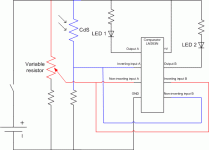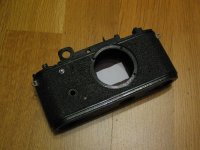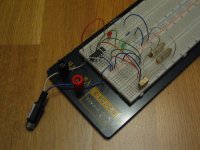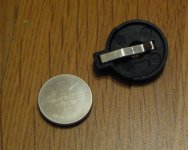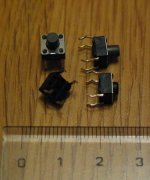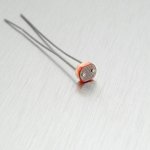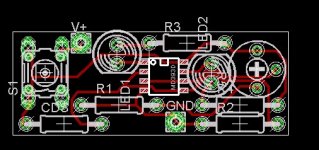wolves3012
Veteran
Spyderman,
I can see a few problems with your circuit, sorry to pour cold water on it...
1) I can see what you were thinking in the circuit, but with no hysteresis the minutest changes would make the LEDs go on & off like mad at the "null" point. A has been suggested elsewhere, an op-amp , with feedback, would be a better choice.
2) Comparators are prone to latch-up . The resistance of a CDS cell can fall to a couple of hundred ohms in bright light, enough to take the inputs close to +ve supply and cause latch-up. Lack of supply decoupling in your circuit (presumably you'd want small batteries) would make that even more likely. You need to limit the input voltage swing by inserting suitable resistors in both sides of the input chains.
3) There is a huge variation in intensity to be catered for, which may mean that your "meter" is not useful in some situations.
4) A CDS cell may simply not be sensitive enough to be useful when using reflected light off a white patch on the curtains - I may be wrong on that since I've never tried it but it could be a deciding factor.
5) There will be sensitivity to voltage change as the batteries age. A bridge circuit to find a null point would be immune to such changes to a large degree. A dual op-amp would allow one amp to be used for the bridge and the other as an inverter to give the over/under indications. It would be easy enough to get a mixture of LED colours that way too. Be generous with supply voltage too, something like a 12V cigarette-lighter/car remote-locking battery would be better than a couple of cells (PX23 springs to mind but I may have that wrong). Comparators and op-amps generally have poor performance on 3V or so.
I'm not claiming to be an electronics expert, but it's been a hobby for many years. I'd be happy for you to prove me wrong on any of the above! Oh, and if you go ahead - good luck!
I can see a few problems with your circuit, sorry to pour cold water on it...
1) I can see what you were thinking in the circuit, but with no hysteresis the minutest changes would make the LEDs go on & off like mad at the "null" point. A has been suggested elsewhere, an op-amp , with feedback, would be a better choice.
2) Comparators are prone to latch-up . The resistance of a CDS cell can fall to a couple of hundred ohms in bright light, enough to take the inputs close to +ve supply and cause latch-up. Lack of supply decoupling in your circuit (presumably you'd want small batteries) would make that even more likely. You need to limit the input voltage swing by inserting suitable resistors in both sides of the input chains.
3) There is a huge variation in intensity to be catered for, which may mean that your "meter" is not useful in some situations.
4) A CDS cell may simply not be sensitive enough to be useful when using reflected light off a white patch on the curtains - I may be wrong on that since I've never tried it but it could be a deciding factor.
5) There will be sensitivity to voltage change as the batteries age. A bridge circuit to find a null point would be immune to such changes to a large degree. A dual op-amp would allow one amp to be used for the bridge and the other as an inverter to give the over/under indications. It would be easy enough to get a mixture of LED colours that way too. Be generous with supply voltage too, something like a 12V cigarette-lighter/car remote-locking battery would be better than a couple of cells (PX23 springs to mind but I may have that wrong). Comparators and op-amps generally have poor performance on 3V or so.
I'm not claiming to be an electronics expert, but it's been a hobby for many years. I'd be happy for you to prove me wrong on any of the above! Oh, and if you go ahead - good luck!


